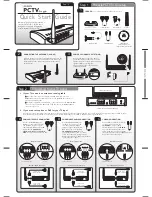
Service manual CP 385 / CP785
- 34 -
FUNCTIONAL DESCRIPTION OF VIDEO PROCESSOR Vision IF amplifier
The vision IF amplifier can demodulate signals with positive and negative modulation. The PLL
demodulator is completely alignment-free.
The VCO of the PLL circuit is internal and the frequency is fixed to the required value by using the
clock frequency of the
µ
-Controller/Teletext decoder as a reference. The setting of the various
frequencies is made by the controlling software in subaddress 27H (38.9
Mhz for all system except L’
or 33.9 MHz for system L’). Because of the internal VCO the IF circuit has a high immunity to EMC
interferences.
QSS Sound circuit
The sound IF amplifier is similar to the vision IF amplifier
and has an external AGC decoupling capacitor.
The single reference QSS mixer is realised by
a multiplier. In this multiplier the SIF signal is converted
to the intercarrier frequency by
mixing it with the regenerated picture carrier from the VCO. The mixer
output signal is supplied to the output via a high-pass filter for attenuation of the residual video signals.
With this system a high performance hi-fi stereo sound processing can be achieved.
Video switches
The video switch has one input for an external CVBS or Y/C signal. The selected CVBS signal can be
supplied to pin 38, the IF video output. The selection between both signals is realised by the controlling
software in subaddress 22H.
The video ident circuit is connected to the selected signal. This ident circuit is independent of the
synchronisation.
Synchronisation circuit
The IC contains separator circuits for the horizontal and vertical sync pulses and a data-slicing circuit
which extracts the digital teletext data from the analogue signal.
The horizontal drive signal is obtained from an internal VCO which is running at a frequency of 25
MHz. This oscillator is stabilised to this frequency by using a 12 MHz signal coming from the
reference oscillator of the
µ
-Controller/Teletext decoder.
The horizontal drive is switched on and off via the soft start/stop procedure. This function is realised
by means of variation of the TON of the horizontal drive pulses.
The vertical synchronisation is realised by means of a divider circuit. The vertical ramp generator needs
an external resistor and capacitor. For the vertical drive a differential output current is available. The
outputs are DC coupled to the vertical output stage.
Summary of Contents for DTA-20 T1
Page 17: ...Service manual CP 385 CP785 16...
Page 21: ...Service manual CP 385 CP785 20...
Page 34: ...Service manual CP 385 CP785 33 5 Circuit description 5 1 Block diagram...
Page 39: ...Service manual CP 385 CP785 38 Chassis block diagram IF...
Page 43: ...Service manual CP 385 CP785 42 Sound signal flow diagram...
Page 70: ...69 Service Manual cp 385 cp 785 7 Exploded View 7 1 DTA 20T1...
Page 73: ...72 7 4 DTA 20T8 Service Manual cp 385 cp 785...
Page 74: ...73 7 5 DTA 21T1 Service Manual cp 385 cp 785...
Page 76: ...75 7 7 DTA 21T5 Service Manual cp 385 cp 785...
Page 77: ...76 7 8 DTA 21T9 Service Manual cp 385 cp 785...
Page 79: ...78 Service Manual cp 385 cp 785 7 10 DTE 25G6...
Page 80: ...79 Service Manual cp 385 cp 785 7 11 DTE 25G7...
Page 82: ...81 7 13 DTE 28G6 Service Manual cp 385 cp 785...
Page 90: ......
Page 91: ......
















































